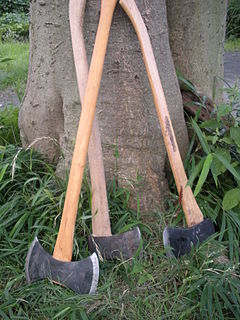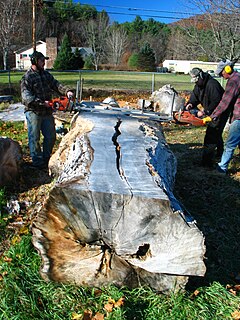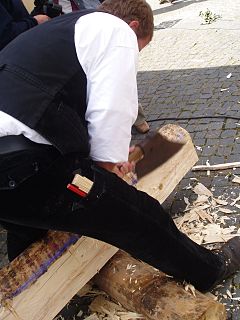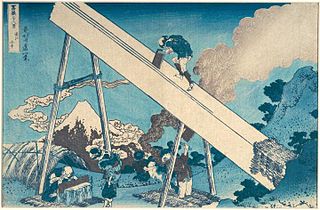 W
WAn axe is an implement that has been used for millennia to shape, split and cut wood, to harvest timber, as a weapon, and as a ceremonial or heraldic symbol. The axe has many forms and specialised uses but generally consists of an axe head with a handle, or helve.
 W
WA broadaxe is a large-(broad) headed axe. There are two categories of cutting edge on broadaxes, both are used for shaping logs by hewing. On one type, one side is flat and the other side beveled, a basilled edge, also called a side axe, single bevel, or chisle-edged axe. On the other type, both sides are beveled, sometimes called a double bevel axe, which produces a scalloped cut. On the basilled broadaxe the handle may curve away from the flat side to allow an optimal stance by the hewer in relation to the hewn surface. The flat blade is to make the flat surface but can only be worked from one direction and are right-handed or left-handed. The double bevel axe has a straight handle can be swung with either side against the wood. A double beveled broad axe can be used for chopping or notching and hewing. When used for hewing, a notch is chopped in the side of the log down to a marked line, called scoring. The pieces of wood between these notches are removed with an axe called joggling and then the remaining wood is chopped away to the line.
 W
WA chainsaw mill or PortaMill or Alaskan mill is a type of sawmill incorporating a chainsaw, that is used by one or two operators to mill logs into lumber for use in furniture, construction and other uses.
 W
WA frame saw or sash saw is a type of saw which consists of a relatively narrow and flexible blade held under tension within a rectangular frame. They are used for cutting wood or stone. The blade is held perpendicular to the plane of the frame, so that the material being cut passes through the center of the frame. Frame saws for use with wood are rip saws operated as a hand saw or powered in a sawmill. Frame saws used for cutting stone were powered saws in stone mills.
 W
WIn woodworking, hewing is the process of converting a log from its rounded natural form into lumber (timber) with more or less flat surfaces using primarily an axe. It is an ancient method, and before the advent of the industrial-era type of sawmills, it was a standard way of squaring up wooden beams for timber framing. Today it is still used occasionally for that purpose by anyone who has logs, needs beams, and cannot or would prefer not to pay for finished lumber. Thus homesteaders on frugal budgets, for example, may hew their own lumber rather than buy it.
 W
WA saw pit or sawpit is a pit over which lumber is positioned to be sawed with a long two-handled saw by two people, one standing above the timber and the other below. It was used for producing sawn planks from tree trunks, which could then be cut down into boards, pales, posts, etc. Many towns, villages and country estates had their own saw pits. The greatest user of sawn timber in past centuries was the shipbuilding industry.
 W
WA sawmill or lumber mill is a facility where logs are cut into lumber. Modern sawmills use a motorized saw to cut logs lengthwise to make long pieces, and crosswise to length depending on standard or custom sizes. The "portable" sawmill is of simple operation. The log lies flat on a steel bed, and the motorized saw cuts the log horizontally along the length of the bed, by the operator manually pushing the saw. The most basic kind of sawmill consists of a chainsaw and a customized jig, with similar horizontal operation.
 W
WSawyer is an occupational term referring to someone who saws wood, particularly using a pit saw either in a saw pit or with the log on trestles above ground or operates a sawmill. One such job is the occupation of someone who cuts lumber to length for the consumer market, a task now often done by end users or at lumber and home improvement stores.
 W
WA shingle weaver (US) or shingler (UK) is an employee of a wood products mill who engages in the creation of wooden roofing shingles or the closely related product known as "shakes." In the Pacific Northwest region of the United States, historically the leading producer of this product, such shingles are generally made of Western Red Cedar, an aromatic and disease-resistant wood indigenous to the area. The use of the term "weaver" for a shingle maker related to the way in which the workers fitted the shingles together in bundles but the meaning has extended to anyone who works in a shingle mill.
 W
WUnderbucking is a type of log bucking where the cuts are made upwards from the lower side of a suspended log. It is the opposite of overbucking, cutting from the top side down. The tool supporting a saw in such a cut is known as the "underbuck".
 W
WA whipsaw or pitsaw was originally a type of saw used in a saw pit, and consisted of a narrow blade held rigid by a frame and called a frame saw or sash saw. This evolved into a straight, stiff blade without a frame, up to 14 feet long and with a handle at each end, the upper called the tiller and the lower one being the box, so called from its appearance and because it could be removed when the saw was taken out of one cut to be positioned in another. It was used close to the felling site to reduce large logs into beams and planks.
 W
WIn woodworking, veneer refers to thin slices of wood and sometimes bark, usually thinner than 3 mm, that typically are glued onto core panels to produce flat panels such as doors, tops and panels for cabinets, parquet floors and parts of furniture. They are also used in marquetry. Plywood consists of three or more layers of veneer. Normally, each is glued with its grain at right angles to adjacent layers for strength. Veneer beading is a thin layer of decorative edging placed around objects, such as jewelry boxes. Veneer is also used to replace decorative papers in Wood Veneer HPL. Veneer is also a type of manufactured board.